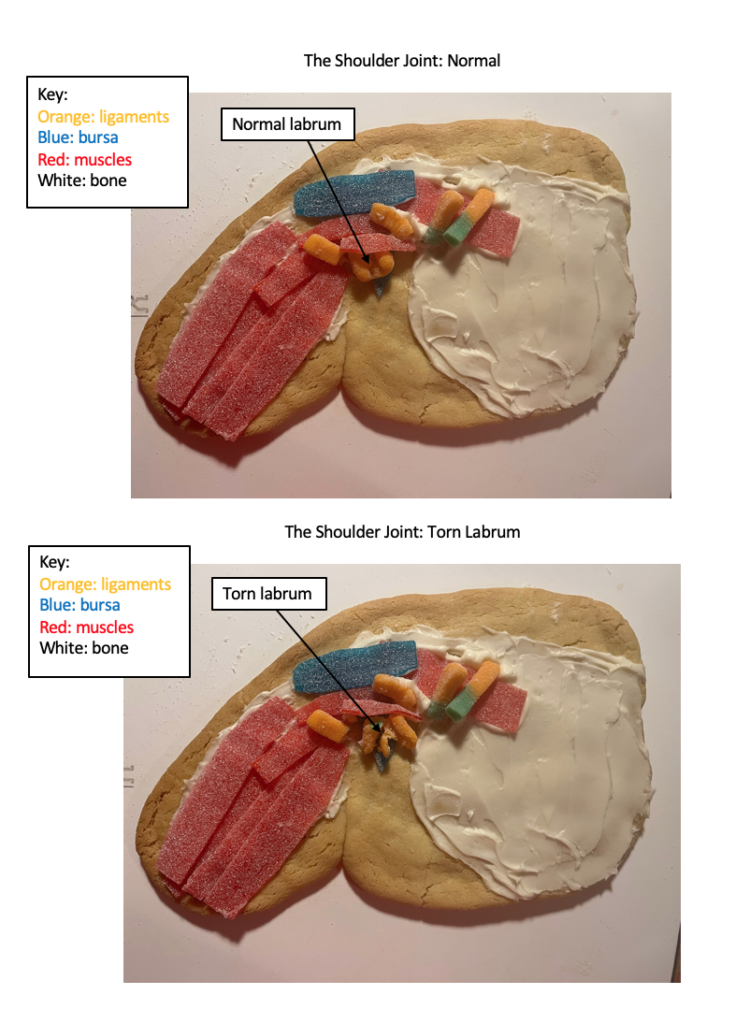By: Bridgette Bourgouin
Humans have various joints around our bodies that help us to move, extend, and rotate. One of the most used joints in the body is the shoulder joint. The shoulder joint is a synovial ball-and-socket joint that allows us to move our shoulder in various ways. The shoulder joint is prone to dislocations because the glenoid (a part of the scapula) is shallow and connects with a small part of the humeral head (Chang et al, 2022). The shoulder is the most commonly dislocated joint in the body. During a shoulder dislocation, ligaments can be torn, bones can fracture, and nerve damage can occur (Cutts et al, 2009). A dislocation to the shoulder can cause a decreased range of motion with pain. The objective of focus for this project is to describe the movement of bones using the proper terminology. The shoulder joint is the main joint that will be discussed along with how dislocations occur and how range of motion is affected.
Humans would be limited without the movement that our shoulder allows. The shoulder is a synovial joint. A synovial joint is a joint that is filled with fluid-filled space located where the surfaces of the bones meet (Betty et al, 2017, pg. 363). Ligaments help hold the bones in place and support the joint by resisting abnormal movements. The shoulder is also known as a ball-and-socket joint because the head of the humerus matches up with the glenoid cavity of the scapula (Betty et al, 2017, pg. 367). The shoulder can move in anterior-posterior and medial-lateral directions and it can also rotate along its long axis. The shallow socket of the glenoid cavity allows the shoulder to have a large range of motion. The shoulder joint allows us to abduct and adduct our arms. Abduction moves the arm away from our body and adduction brings the arm down towards our body. The shoulder joint can rotate our arm internally or externally. Circumduction is a motion that is possible with the shoulder joint since we can move our arms in circles. The shoulder joint also allows for us to extend our arms behind us and have our arms are in front of us, a movement called flexion (Chang et al, 2022). All of these movements are natural for the shoulder joint. Dislocations can occur when an outside force causes the shoulder to move in unnatural way with enough force to shift the bones out of place.
There are a few types of shoulder dislocations which include anterior dislocation, posterior dislocation, inferior dislocation, and anterior-superior dislocations (Cutts et al, 2009)). Shoulder dislocations can be partial, called a subluxation, or complete dislocations. A common injury after a dislocation is injury to the axillary nerve which occurs in over 40% of dislocations (Cutts et al, 2009)). This injury is usually not permanent and resolves once the shoulder is back in its proper place. Fractures can occur and are clinically relevant in about 25% of dislocations. Some examples of fractures include the Bankart lesion and the Hill-Sachs deformity. Dislocations can also cause ligaments to tear, causing a more complex dislocation and laxity of the shoulder. Laxity of the shoulder can cause abnormal movements, especially if ligaments are stretched out. However, range of motion can be can be altered by pain, which can decrease range of motion. Some examples of tears include a rotator cuff tear or a labrum tear. A few examples of these injuries can be seen in the artwork submitted.
After a shoulder dislocation has occurred, it is best to be checked by a medical professional to be sure that nothing was injured and that the shoulder has returned to its proper place. Acute treatment for a shoulder dislocation is a reduction, where the bones are put back into placed. Treatments for after a shoulder dislocation can include rest, physical therapy, or even surgery. According to a study, evidence showed that for first time shoulder dislocations, those that had surgery for a labral injury had fewer reoccurring dislocations ((Kavaia et al, 2018). Shoulder instability is a common symptom after dislocating. Surgery significantly decreases the range of motion of the shoulder joint. With the help of physical therapy, range of motion can be increased and you can gain back your full range of motion, if nerve damage was not sustained.
Dislocations are to be taken seriously because once a joint has dislocated, the joint is more likely to dislocate again. This occurs because the tissue does not heal properly or it becomes stretched out (Kavaia et al, 2018). Age also plays a factor since younger people have higher activity levels than older people. Rotator cuff tears and glenoid fractures also increase the risk of a dislocations reoccurring. Overall, the shoulder joint is responsible for many of our arms movements and has the most extensive range of motion for a joint. Dislocations can alter this range of motion, but with treatment and physical therapy, this range of motion can be regained.
References
Betts, J. G., Desaix, P., Johnson, E., Johnson, J. E., Korol, O., Kruse, D., Poe, B., Wise, J., Womble, M. D., & Young, K. A. (2017). Anatomy & Physiology. OpenStax College, Rice University.
Chang LR, Anand P, Varacallo M. Anatomy, Shoulder and Upper Limb, Glenohumeral Joint. (2022 Aug 8). StatPearls Publishing; 2022 Jan. https://www.ncbi.nlm.nih.gov/books/NBK537018/
Cutts, S., Prempeh, M., Drew, S. (2009, January). Anterior shoulder dislocation. Annals of the Royal College of Surgeons of England. https://www.ncbi.nlm.nih.gov/pmc/articles/PMC2752231/
Kavaja, L., Lähdeoja, T., Malmivaara, A., & Paavola, M. (2018, December). Treatment after traumatic shoulder dislocation: A systematic review with a network meta-analysis. British journal of sports medicine. https://www.ncbi.nlm.nih.gov/pmc/articles/PMC6241619/#SP15

